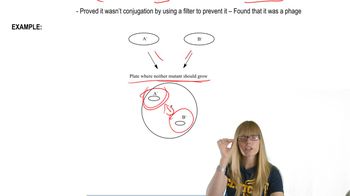Table of contents
- 1. Introduction to Genetics51m
- 2. Mendel's Laws of Inheritance3h 37m
- 3. Extensions to Mendelian Inheritance2h 41m
- 4. Genetic Mapping and Linkage2h 28m
- 5. Genetics of Bacteria and Viruses1h 21m
- 6. Chromosomal Variation1h 48m
- 7. DNA and Chromosome Structure56m
- 8. DNA Replication1h 10m
- 9. Mitosis and Meiosis1h 34m
- 10. Transcription1h 0m
- 11. Translation58m
- 12. Gene Regulation in Prokaryotes1h 19m
- 13. Gene Regulation in Eukaryotes44m
- 14. Genetic Control of Development44m
- 15. Genomes and Genomics1h 50m
- 16. Transposable Elements47m
- 17. Mutation, Repair, and Recombination1h 6m
- 18. Molecular Genetic Tools19m
- 19. Cancer Genetics29m
- 20. Quantitative Genetics1h 26m
- 21. Population Genetics50m
- 22. Evolutionary Genetics29m
13. Gene Regulation in Eukaryotes
Overview of Eukaryotic Gene Regulation
Problem 30
Textbook Question
The localization and translational control of actin mRNA is important for the migration of fibroblasts and is regulated by the activity of the kinase Src. Src is activated by phosphorylation when cell surface receptors bind to signaling molecules. How might this system lead to a cell migrating in a specific direction? How might the cell migrate away from repulsive signals?
 Verified step by step guidance
Verified step by step guidance1
Understand that Src kinase is activated by phosphorylation in response to external signals binding to cell surface receptors, which initiates intracellular signaling pathways.
Recognize that activated Src can regulate the localization and translation of actin mRNA, leading to localized actin protein synthesis at specific regions of the cell.
Consider that localized actin polymerization at the leading edge of the cell promotes protrusion and movement toward attractive signals, effectively guiding directional migration.
For migration away from repulsive signals, understand that Src activity might be inhibited or differently regulated in regions of the cell exposed to these signals, reducing actin polymerization there and causing the cell to move in the opposite direction.
Integrate these concepts to see how spatial regulation of Src activity and actin mRNA translation creates asymmetry in the cytoskeleton, enabling the cell to migrate directionally in response to both attractive and repulsive cues.
 Verified video answer for a similar problem:
Verified video answer for a similar problem:This video solution was recommended by our tutors as helpful for the problem above
Video duration:
47sPlay a video:
Was this helpful?
Key Concepts
Here are the essential concepts you must grasp in order to answer the question correctly.
mRNA Localization and Translational Control
mRNA localization refers to the spatial distribution of mRNA molecules within a cell, allowing proteins to be synthesized at specific sites. Translational control regulates when and where these mRNAs are translated into proteins, enabling localized responses such as actin polymerization at the leading edge during cell migration.
Recommended video:
Guided course

Translation Termination
Src Kinase Activation and Signal Transduction
Src is a tyrosine kinase activated by phosphorylation upon receptor binding to extracellular signals. Activated Src transmits signals inside the cell, modulating downstream pathways that influence cytoskeletal dynamics and mRNA translation, thereby directing cellular behaviors like migration.
Recommended video:
Guided course

Transduction
Directional Cell Migration and Response to Guidance Cues
Cells migrate directionally by interpreting attractive and repulsive signals through surface receptors. Attractive signals activate pathways promoting actin assembly at the front, while repulsive signals inhibit these processes or promote disassembly, enabling the cell to move toward favorable environments and away from harmful stimuli.
Recommended video:
Guided course

New Alleles and Migration
Related Videos
Related Practice
Textbook Question
The Drosophila even-skipped (eve) gene is expressed in seven stripes in the segmentation pattern of the embryo. A sequence segment of 8 kb 5' to the transcription start site (shown as in the accompanying figure) is required to drive expression of a reporter gene (lacZ) in the same pattern as the endogenous eve gene. Remarkably, expression of most of the seven stripes appears to be specified independently, with stripe 2 expression directed by regulatory sequences in the region 1.7 kb 5' to the transcription start site. To further examine stripe 2 regulatory sequences, you create a series of constructs, each containing different fragments of the 1.7-kb region of the 5' sequence. In the lower part of the figure, the bars at left represent the sequences of DNA included in your reporter gene constructs, and the + and − signs at right indicate whether the corresponding eve-lacZ reporter gene directs stripe 2 expression in Drosophila embryos transformed through P element mediation. How would you interpret the results—that is, where do the regulatory sequences responsible for stripe 2 expression reside?
751
views


